- HOME
- > Product
- > Power Supply and Power Control Products
- > Power Amplifier
- > High Speed Bipolar Amplifier HSA series : Features
High Speed Bipolar Amplifier
High Speed Bipolar Amplifier
HSA seriesFeatures
Stable output under various load conditions
Four-quadrant operation
The operation range of the HSA series is four quadrants as shown in the figure on
the right.
Current sources and sinks regardless of positive or negative output voltage.
When an AC voltage is applied to a load including capacitors and coils, current
returns from the load.
In this case, a typical AC power supply or amplifier may not be able to drive the
load.
The HSA series operates stably not only with capacitive loads such as a
piezoelectric element or solenoid but also with inductive loads because of its
4-quadrant output.
4-quadrant operation and Capacitive
and Inductive loads
When AC power is applied to a capacitor or inductor, the AC current of these loads
create a 90° phase difference with the applied AC voltage, but when the
instantaneous values of voltage and current are plotted on a 4-quadrant graph, they
pass through all four quadrants.
When applying alternating current to capacitors and inductors in this way, a
4-quadrant operation is necessary.
On the other hand, a general DC power supply can only be driven in the first and
third quadrants on the graph, therefore it is not suitable for driving anything but
resistive loads.
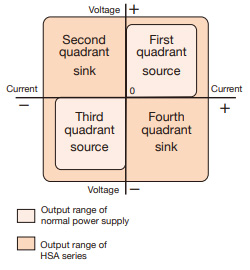
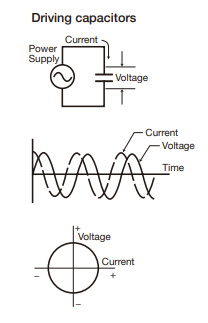
Fast response, wide frequency bandwidth, DC to Max. 1MHz
High speed and high slew rate reproduce transient
and repetitive operations with good step response.
HSA series outputs AC and DC. Therefore, it is possible to output positive/negative
asymmetric signals or signals in which AC is superimposed on DC.
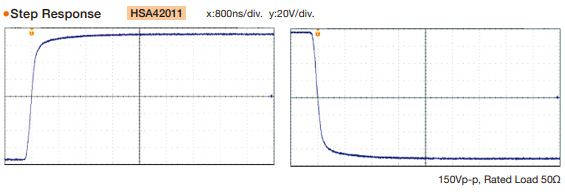
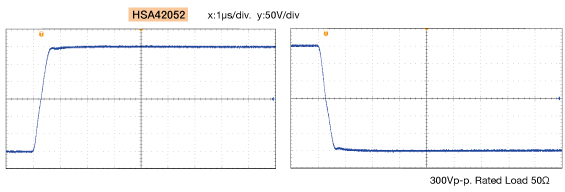
Low output impedance
Due to the output impedance of the power supply,
the rise time of a capacitive or inductive load is delayed.
The HSA series maintains a low output impedance over the entire frequency band,
suppresses voltage drop due to load, and operates at high speed.
Effect on Rise Time
In below figure, if the resistance of the
output
impedance of the power supply is R, the inductance is L, and the load capacitance is
C,
the rise will be slow because only R exists.
When L = 0, it takes C×R (seconds) to rise to about 60% of the final value
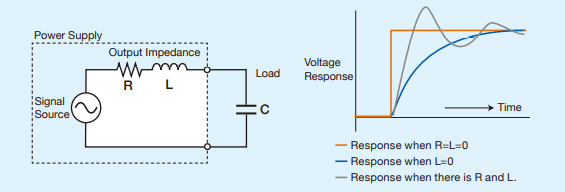
Convenient functions for various purposes
Gain setting
Set seamlessly by combining selectable fixed
gain and variable gain x1 to x3 ( fine adjustment potentiometer)
・HSA42011 / HSA42012 / HSA42014 : ×1, ×10, ×20, ×50
・HSA42051 / HSA42052 : ×1, ×20, ×40, ×100
With a gain ×1 setting, it is used as a buffer amplifier that
outputs at the same voltage as the external signal generator setting.

Output polarity switching
With the [INVT] switch on front panel, an
amplification can be selected which the input and output phases are in the same or
opposite polarity.
Balanced connection by two units of HSA series with output polarity set to opposite,
the output voltage and power are doubled.
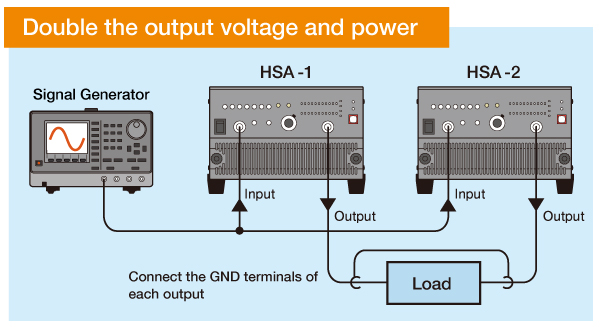
The output of the signal generator is
divided
and input to HSA −1. HSA −2 has a reverse phase output towards HSA −1.
The load must be isolated from ground potentials and signal sources. It is also
called BTL (Balanced Transformer Less) connection.
Output DC bias voltage setting
Superimpose a DC bias voltage on the output
voltage.(Setting by 10-turn indicating dial)
・HSA42011 / HSA42012 / HSA42014 : ±75V
・HSA42051 / HSA42052 : ±150V
As a test in which the DC voltage of the load fluctuates, it is possible to
superimpose the AC voltage on the DC voltage.
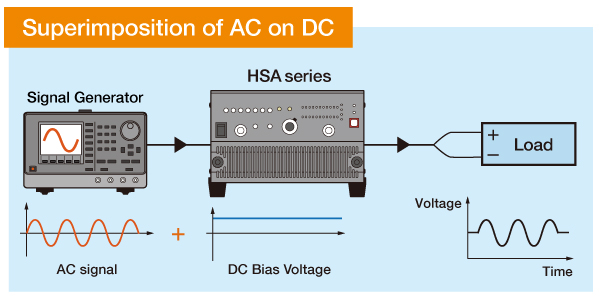
Set the rated DC voltage of the load with
the
DC bias of the HSA and superimpose the AC voltage output from the signal
generator.
It is also possible to sweep the frequency of the AC output from
the
signal generator or superimpose it on white noise.
Output DC offset cancellation function (HSA42051 / HSA42052 only)
When set to AC mode, the DC offset is automatically removed and only AC voltage is output. This function is effective when a transformer or coil is magnetically saturated due to the DC component of the applied voltage.
Protection function
This function protects the load from abnormal conditions such as overload, overvoltage, internal power supply error, internal temperature error and cooling fan error. When an error is detected, the output is turned off or the overload protection function is activated and the error LED lights up. If the abnormal condition continues, the operation is disabled. (Only the power off switch is effective)
Others
● External control
● Output on/off control
● Input A, B, A+B
● Input Impedance 50Ω/10kΩ selectable
● Output voltage
monitor
● Power-on status setting
Frequency Response Data
